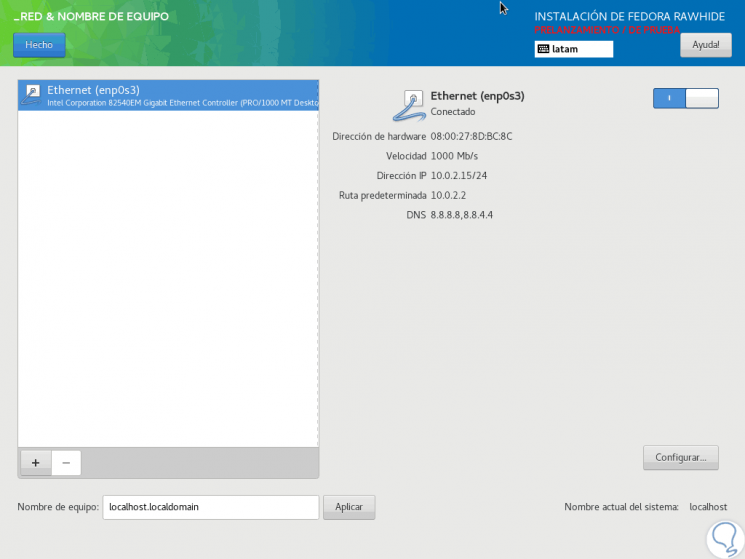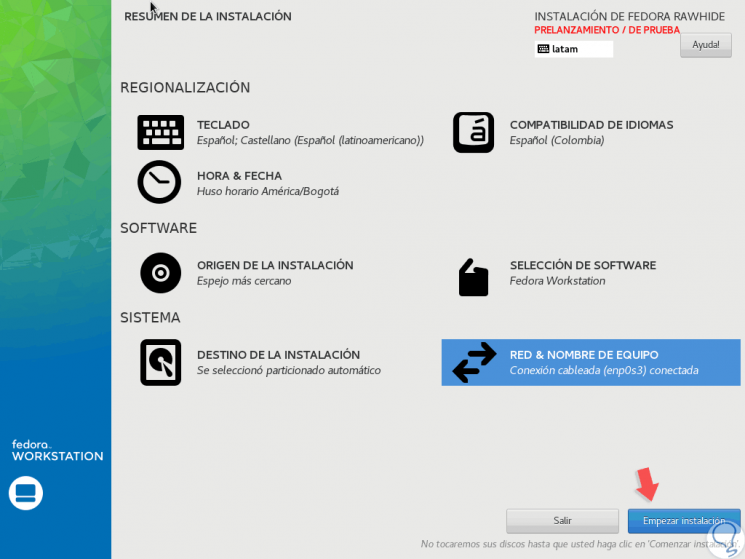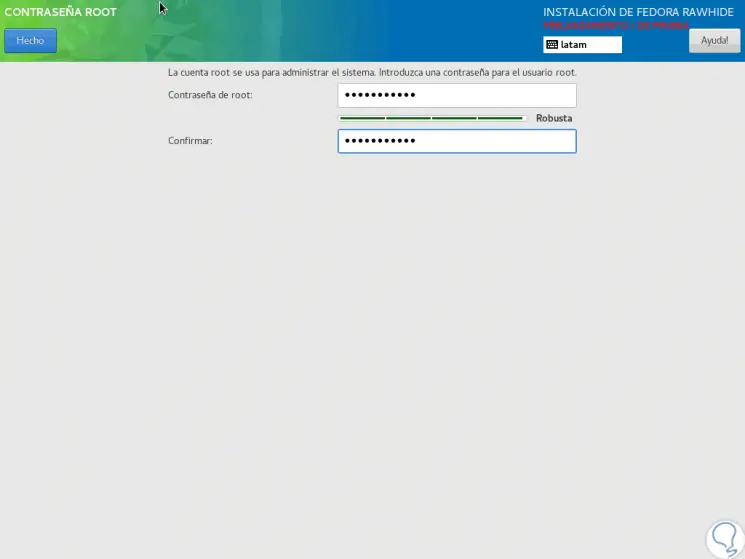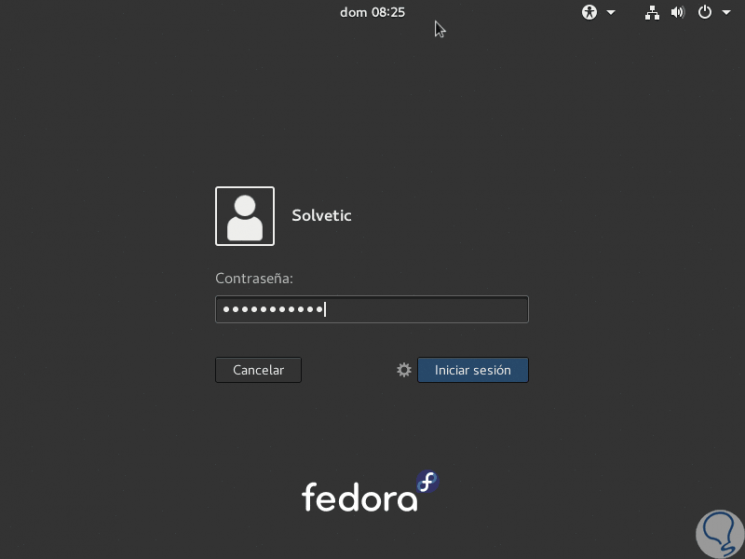As the developers launch a new software product, they do so thinking of improving their previous version , if it exists, adding new functions, updating the ones they have and eliminating others in order to get the most out of it, in the case of operating systems, much more relative and vital aspects are taken into account since it is the work base of millions of users in the world and any error can damage the reputation of the company..
In the case of Linux operating systems, there is a point of advantage and it is that being open source many developers can add extra features to it.
Today at TechnoWikis, we will talk about the news and the installation of the new Linux distribution for Fedora, in this case it will be the 28th edition of this reliable, powerful and known system for all of us..
Fedora launch schedule
Remember that Linux, before launching a product in its final version, allows you to download certain trial versions to detect faults, anomalies and errors in order to work on them and improve the final version of the product.
With Fedora 28 it is not the exception and therefore there is the following schedule of releases:
- January 9, 2018: Change verification point: deadline for submitting the proposal (changes throughout the system).
- January 30, 2018: Change control point: deadline for the presentation of the proposal (autonomous changes).
- January 31, 2018: Mass reconstruction.
- February 2, 2018: Freeze of software chains.
- February 20, 2018: Exchange control point: end date (verifiable) and Branch of Fedora 28 towards Rawhide (Rawhide has features of Fedora 29).
- March 6, 2018: Deadline for software translation, Bodhi Beta Freeze activation point and change verification point: 100% complete system code deadline.
- March 27, 2018: Launch of the beta version.
- May 1, 2018: Final launch of Fedora 28 (GA).
- May 8, 2018: Final launch of Fedora 28.
With this schedule there are few months left to enjoy the different editions of Fedora 28.
Let's check the changes and developments in Fedora 28 remarkable that surely more than one will surprise you..
As we have mentioned, each new operating system has a series of novelties that will make it different from its previous version, in the case of Fedora 28 we have the following:
AArch64 server promotion
With this innovation, it is allowed to promote Aarch64 server technologies to the state of Primary Architecture, this includes the server installer, the DVD installer ISO, the cloud (qcow2 images) and the Docker base images in the same state as others main server architectures and elements such as images or workstation installations, any of the various twists or components of Fedora Atomic are not included.
Anaconda Modularization
With this innovation, the Anaconda installer will be divided into several modules that will communicate through DBus using a stable API.
Annotated Binaries
This change is added so that additional information is stored in binary files compiled by gcc. This information can be used by scripts to verify certain characteristics of the file, such as the strengthening options used or possible ABI conflicts.
Default authselect tool instead of authconfig
With Fedora 28, you have replaced authconfig with authselect since authselect is a default tool to configure PAM and nsswitch.conf. In this transition period, we will have a compatibility tool that will help us with this migration from authconfig to authselect.
Binutils version 2.29.1
The binutils package from version 2.29 to version 2.29.1 has been updated with improvements in errors, but without adding new functionalities.
Adding TCP wrappers
TCP wrappers is a simple tool that allows you to block the incoming connection at the application level thereby increasing network security.
Complementary Modularity
From this edition Fedora 28, Fedora will offer us a new set of software repositories and updates with alternative versions to those sent in the default version thus allowing against one of the most up-to-date operating systems.
Fedora Improvement 28 Boost 1.66
With this improvement, Boost 1.66.0 is added to Fedora 28 which means that Fedora 28 will include a recent upstream Boost version.
GCC8
GCC changes have been made in Fedora 28 to 8.x, this will allow us to rebuild all packages in it, and, optionally, rebuild only some packages with it and rebuild all packages only in Fedora 29.
GHC 8.2
Haskell GHC compiler from main version 8.0.2 to 8.2.2 has been updated.
GNU C Library version 2.27
The glibc library in Fedora 28 was updated to glibc version 2.27.
Glibc update and synchronization with cldr
It will now be possible to update the interleaving data in glibc to a 2015 ISO file (in synchronization with Unicode 8.0.0) and synchronize the interleaving rules of the regional configurations with CLDR.
Updates Hardening Flags for Fedora 28
This change covers changes in Hardening indicators in Fedora 28.
IBus Unicode Typing
IBus core offers us an Emoji dialog in which Fedora users can write emoji annotations and issue the emoji character using IBus, with this improvement, the goal is for the dialogue to also support writing Unicode names (for example, writing "copyright sign "shows U + 00A9).
Change in applications that use libidn to IDNA2008
The objective of this change is to try to depreciate libidn, which supports IDNA2003, and change all applications that use libidn, to libidn2 2.0.0, which is compatible with IDNA2008.
Improvements in battery life in portable computers
This novelty is found in the WorkStation edition of Fedora 28 and allows us to improve the life of the battery, giving us the possibility of enabling several hardware energy saving features by default.
NIS changes to the new libnsl to support IPv6
This novelty affects the entire system, including the change of the NIS components towards the new client-side implementation to support IPv6, while separating the libnsl and nss_nis packages, which were formerly included with glibc.
NSS supports the default SQL file
Now in Fedora 28, it will be possible to change the NSS library by default to use sqlite-based data storage, only when applications do not specify their preferred storage file format.
OpenLDAP uses only shared system certificates by default
With this change, OpenLDAP clients and servers will use only the entire system certificate store by default.
Reduce initial configuration redundancy
In the current system, there is a high level of redundancy between the Anaconda installer and the initial gnome configuration, with this change, we seek to eliminate these redundancies and simplify the initial user experience in Fedora Workstation.
Username nobody
In Fedora 29 we can use "nobody: nobody" as the names of the kernel overflow UID: GID pair, and eliminate the old name "nfsnobody" and the old pair "nobody: nobody" with numbers 99:99.
I replace the libcrypt of glibc with libxcrypt
The goal is to remove libcrypt from glibc.
Ruby 2.5 Inclusion
Ruby 2.5 is the latest stable version of Ruby which includes many new features and improvements to Ruby. With this update from Ruby 2.4 on Fedora 26 to Ruby 2.5 on Fedora 28, Fedora becomes Ruby's highest development platform.
Strong encryption settings
This change in Fedora 28 is focused on updating the current cryptography policy of the entire distribution to disable legacy and unused cryptographic protocols, significantly increasing security.
Glibc Sun RPC interface removal
The purpose of this change throughout the system is the removal of Sun RPC related interfaces from glibc.
Golang 1.10 is added
With the Golang package to the next version 1.10 on Fedora 28, reconstruction of all dependent packages is included.
Kerberos as part of Python
It will now be possible to replace the use of python-krbV and pykerberos with python-gssapi in all Fedora packages to allow their removal from Fedora. rharwood will be responsible for creating all necessary code changes.
Libcurl implementation to use libssh instead of libssh2
libcurl currently uses libssh2 to implement the SSH layer of the SCP and SFTP protocols, now, with this change, libcurl will use the libssh library instead.
mpfr-4.0.0
The MPFR package was updated to version 4.0.0.
time-1.8
A new version 1.8 time tool has been added which changes the output format.
Other changes in Fedora 28
Other changes to consider are:
- Avoid using / usr / bin / python in the creation of RPM
- Update to Fontconfig 2.13
- Integration with VirtualBox guests
- New version of librealsense2
How to install Fedora 28 (Linux)
As we saw at the top, there is a defined Fedora 28 launch schedule, but the Fedora 28 Rawhide developer group gives us the possibility to download various types of ISO images for validation, these ISO images can be found in the following link:
Fedora28 ISO images
There we will have the possibility of using images for versions such as:
Step 1
At the time of downloading the ISO it will be necessary to burn it to a CD, DVD or USB memory and then configure the equipment to allow booting from there.
With this done, this will be the first image we will see of Fedora 28:

Step 2
There we have the following options:
- Install Fedora Rawhide: This option allows us to start the Fedora 28 installation process directly.
- Test this media & install Fedora Rawhide: With this option it will be possible to perform a hardware analysis to verify that everything meets the basic installation requirements.
- Troubleshooting: This option allows us to solve installation errors.
Step 3
In this case we will select the option “Install Fedora Rawhide†and we will see the following window where we will select the Fedora 28 installation language:

Step 4
By clicking on "Continue" we will see the following message:

Step 5
This is because it is a trial version which may still have certain inaccuracies, click on the "I accept my destination" button and then we will access the following page:

Step 6
There we have the following options:
Keyboard
This option allows us to define the system keyboard settings, as well as add or remove keyboards:

Language support
Through this section we can define some of the languages ​​in which Fedora 28 is available:

Time & Date
As the name implies, there it will be possible to define the geographical area and time of the system:

Destination of the installation
In this section we will define the disk on which Fedora 28 is to be installed and we will be able to perform actions such as partitions, drive encryption and more. There we must select the current disk and click on the Done button to confirm the action.

Origin of the installation
Through this section, it will be possible to define a type of network-based installation or through a mirror, for this it is required to enter the respective URLs:

Software selection
It is one of the sections that presents more changes Fedora 28 since from here it will be possible to define multiple features that the operating system will have. Simply activate the desired boxes and click on the Done button for confirmation.

Network & Team Name
Here it will be possible to define the name of the equipment to be used, as well as activate the network, which displays the name of the adapter, assigned IP address and DNS.

Step 7
With all this defined, we must validate that no field has a warning, it will be possible to start the installation process by clicking on the “Start installation†button:

Step 8
By clicking there, we will see the following:

Step 9
We must configure the superuser and the local user of Fedora 28. Click on “Root password†and define the password to assign:

Step 10
Click on the Done button and we will carry out the same process with the local user:

Step 11
Once these steps are defined, we will see the following:

Step 12
There it will be necessary to wait for the system to download the RPMs which have a size of 1.48 GB:

Step 13
Once the process is finished and restart the system we will see the following:

Step 14
Once the system has restarted, we will access Fedora 28 with our credentials created in the previous steps:

Step 15
This will be the setting for this new edition of Fedora:

As we see, this new edition of Fedora promises great news always thinking about the end user and offering the best design, development, compatibility and general use features of the system and its components. We can get to know the different options we have with Fedora 28 while the official version is released.